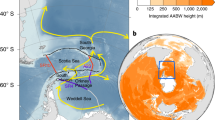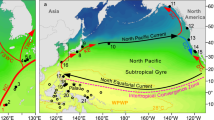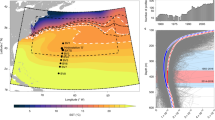Abstract
The anti-cyclonic Beaufort Gyre is the dominant circulation of the Canada Basin and the largest freshwater reservoir in the Arctic Ocean. During the first part of the 2000s, the gyre intensified, expanded and accumulated freshwater. Using an extensive hydrographic dataset from 2003 to 2019, together with updated satellite dynamic ocean topography data, we find that over the past decade the Beaufort Gyre has transitioned to a quasi-stable state in which the increase in sea surface height of the gyre has slowed and the freshwater content has plateaued. In addition, the cold halocline layer, which isolates the warm/salty Atlantic water at depth, has thinned significantly due to less input of cold and salty water stemming from the Pacific Ocean and the Chukchi Sea shelf, together with greater entrainment of lighter water from the eastern Beaufort Sea. This recent transition of the Beaufort Gyre is associated with a southeastward shift in its location as a result of variation in the regional wind forcing. Our results imply that continued thinning of the cold halocline layer could modulate the present stable state, allowing for a freshwater release. This, in turn, could freshen the subpolar North Atlantic, impacting the Atlantic Meridional Overturning Circulation.
This is a preview of subscription content, access via your institution
Access options
Access Nature and 54 other Nature Portfolio journals
Get Nature+, our best-value online-access subscription
$29.99 / 30 days
cancel any time
Subscribe to this journal
Receive 12 print issues and online access
$259.00 per year
only $21.58 per issue
Buy this article
- Purchase on Springer Link
- Instant access to full article PDF
Prices may be subject to local taxes which are calculated during checkout




Similar content being viewed by others
Data availability
The historical hydrographic data are obtained from the following sources: (1) Unified Database for Arctic and Subarctic Hydrography (https://doi.pangaea.de/10.1594/PANGAEA.872931); (2) World Ocean Database 2018 (https://www.ncei.noaa.gov/products/world-ocean-database); (3) Arctic Data Center (https://arcticdata.io/catalog/data); (4) Beaufort Gyre Exploration Project (https://www2.whoi.edu/site/beaufortgyre/data/data-overview/); (5) Pacific Marine Environmental Laboratory (https://www.pmel.noaa.gov/data-links); (6) NOAA Alaska Fisheries Science Center (https://data.eol.ucar.edu/dataset/); (7) University of Alaska Fairbanks Institute of Marine Science (available at the Arctic Ocean Observing System, http://www.aoos.org); (8) Fisheries and Oceans Canada’s Institute of Ocean Sciences (https://www.dfo-mpo.gc.ca/science/publications/index-eng.htm); (9) JAMSTEC (http://www.godac.jamstec.go.jp/darwin/e/); and (10) Korea Polar Data Center (https://kpdcopen.kopri.re.kr). The dynamic ocean topography data produced by ref. 42 and the updated dynamic ocean topography data from 2011 to 2019 are available at http://www.cpom.ucl.ac.uk/dynamic_topography/. The GRACE data can be accessed via https://sealevel.nasa.gov/data/dataset/?identifier=SLCP_CSR-RL06-Mascons-v02_RL06_v02. The ERA5 reanalysis data can be obtained from the ECMWF (https://rmets.onlinelibrary.wiley.com/doi/10.1002/qj.3803). The GLORYS12 reanalysis is available at the Copernicus Marine and Environment Monitoring Service (https://data.marine.copernicus.eu/product/GLOBAL_MULTIYEAR_PHY_001_030/description). The JAMSTEC mooring data at the mouth of the Barrow Canyon from 2003 to 2019 are available at https://www.jamstec.go.jp/iace/e/report/. The monthly time series of the Arctic Oscillation index is obtained from NOAA’s Climate Prediction Center (https://www.cpc.ncep.noaa.gov/products/precip/CWlink/daily_ao_index/ao.shtml). The bathymetry data used in the study are from the International Bathymetric Chart of the Arctic Ocean version 3 (ref. 49) (https://www.gebco.net/about_us/committees_and_groups/scrum/ibcao/ibcao_v3.html).
Code availability
The MATLAB scripts used to compute the freshwater content and to calculate the Lagrangian particle trajectories can be accessed upon request to the corresponding author.
References
Proshutinsky, A., Krishfield, R. & Timmermans, M. L. Introduction to special collection on Arctic Ocean modeling and observational synthesis (FAMOS) 2: Beaufort Gyre phenomenon. J. Geophys. Res. Oceans 125, e2019JC015400 (2020).
Proshutinsky, A. et al. Beaufort Gyre freshwater reservoir: state and variability from observations. J. Geophys. Res. Oceans 114, C00A10 (2009).
Timmermans, M. L. & Marshall, J. Understanding Arctic Ocean circulation: a review of ocean dynamics in a changing climate. J. Geophys. Res. Oceans 125, e2018JC014378 (2020).
Steele, M. et al. Circulation of summer Pacific halocline water in the Arctic Ocean. J. Geophys. Res. Oceans 109, C02027 (2004).
Proshutinsky, A. et al. Analysis of the Beaufort Gyre freshwater content in 2003–2018. J. Geophys. Res. Oceans 124, 9658–9689 (2019).
Armitage, T. W. et al. Arctic Ocean surface geostrophic circulation 2003–2014. Cryosphere 11, 1767–1780 (2017).
Giles, K. A., Laxon, S. W., Ridout, A. L., Wingham, D. J. & Bacon, S. Western Arctic Ocean freshwater storage increased by wind-driven spin-up of the Beaufort Gyre. Nat. Geosci. 5, 194–197 (2012).
Zhong, W., Steele, M., Zhang, J. & Cole, S. T. Circulation of Pacific winter water in the western Arctic Ocean. J. Geophys. Res. Oceans 124, 863–881 (2019).
Regan, H. C., Lique, C. & Armitage, T. W. The Beaufort Gyre extent, shape, and location between 2003 and 2014 from satellite observations. J. Geophys. Res. Oceans 124, 844–862 (2019).
Tsamados, M. et al. Impact of variable atmospheric and oceanic form drag on simulations of Arctic sea ice. J. Phys. Oceanogr. 44, 1329–1353 (2014).
Yang, J. The seasonal variability of the Arctic Ocean Ekman transport and its role in the mixed layer heat and salt fluxes. J. Clim. 19, 5366–5387 (2006).
Meneghello, G., Marshall, J., Timmermans, M.-L. & Scott, J. Observations of seasonal upwelling and downwelling in the Beaufort Sea mediated by sea ice. J. Phys. Oceanogr. 48, 795–805 (2018).
Manucharyan, G. E. & Spall, M. A. Wind-driven freshwater buildup and release in the Beaufort Gyre constrained by mesoscale eddies. Geophys. Res. Lett. 43, 273–282 (2016).
Zhang, J. et al. The Beaufort Gyre intensification and stabilization: a model‐observation synthesis. J. Geophys. Res. Oceans 121, 7933–7952 (2016).
Itoh, M., Nishino, S., Kawaguchi, Y. & Kikuchi, T. Barrow Canyon volume, heat, and freshwater fluxes revealed by long‐term mooring observations between 2000 and 2008. J. Geophys. Res. Oceans 118, 4363–4379 (2013).
Lin, P., Pickart, R. S., Moore, G., Spall, M. A. & Hu, J. Characteristics and dynamics of wind-driven upwelling in the Alaskan Beaufort Sea based on six years of mooring data. Deep Sea Res. II 162, 79–92 (2019).
Lin, P., Pickart, R. S., Våge, K. & Li, J. Fate of warm Pacific water in the Arctic Basin. Geophys. Res. Lett. 48, e2021GL094693 (2021).
Timmermans, M. L., Marshall, J., Proshutinsky, A. & Scott, J. Seasonally derived components of the Canada Basin halocline. Geophys. Res. Lett. 44, 5008–5015 (2017).
Krishfield, R. A. et al. Deterioration of perennial sea ice in the Beaufort Gyre from 2003 to 2012 and its impact on the oceanic freshwater cycle. J. Geophys. Res. Oceans 119, 1271–1305 (2014).
Itoh, M. et al. Interannual variability of Pacific winter water inflow through Barrow Canyon from 2000 to 2006. J. Oceanogr. 68, 575–592 (2012).
Lin, P. et al. On the nature of wind-forced upwelling and downwelling in Mackenzie Canyon, Beaufort Sea. Prog. Oceanogr. 198, 102674 (2021).
Stammer, D. Steric and wind‐induced changes in TOPEX/Poseidon large‐scale sea surface topography observations. J. Geophys. Res. Oceans 102, 20987–21009 (1997).
Woodgate, R. A. & Peralta‐Ferriz, C. Warming and freshening of the Pacific inflow to the Arctic from 1990–2019 implying dramatic shoaling in Pacific winter water ventilation of the Arctic water column. Geophys. Res. Lett. 48, e2021GL092528 (2021).
Pacini, A. et al. Characteristics and transformation of Pacific winter water on the Chukchi Sea shelf in late spring. J. Geophys. Res. Oceans 124, 7153–7177 (2019).
Pickart, R. S. et al. Circulation of winter water on the Chukchi shelf in early summer. Deep Sea Res. II 130, 56–75 (2016).
Lin, P. et al. Circulation in the vicinity of Mackenzie Canyon from a year-long mooring array. Prog. Oceanogr. 187, 102396 (2020).
Nikolopoulos, A. et al. The western Arctic boundary current at 152° W: structure, variability, and transport. Deep Sea Res. II 56, 1164–1181 (2009).
Leng, H., Spall, M. A., Pickart, R. S., Lin, P. & Bai, X. Origin and fate of the Chukchi slope current using a numerical model and in-situ data. J. Geophys. Res. Oceans 126, 2021JC017291 (2021).
Li, M. et al. Circulation of the Chukchi Sea shelfbreak and slope from moored timeseries. Prog. Oceanogr. 172, 14–33 (2019).
Timmermans, M.-L. & Toole, J. M. The Arctic Ocean’s Beaufort Gyre. Annu. Rev. Mar. Sci. 15, 223–248 (2023).
Karpouzoglou, T., de Steur, L., Smedsrud, L. H. & Sumata, H. Observed changes in the Arctic freshwater outflow in Fram Strait. J. Geophys. Res. Oceans 127, e2021JC018122 (2022).
Rudels, B. Volume and freshwater transports through the Canadian Arctic Archipelago-Baffin Bay system. J. Geophys. Res. Oceans 116, C00D10 (2011).
Zhang, J. et al. Labrador Sea freshening linked to Beaufort Gyre freshwater release. Nat. Commun. 12, 1229 (2021).
Le Bras, I. et al. How much Arctic fresh water participates in the subpolar overturning circulation? J. Phys. Oceanogr. 51, 955–973 (2021).
Gelderloos, R., Straneo, F. & Katsman, C. A. Mechanisms behind the temporary shutdown of deep convection in the Labrador Sea: lessons from the Great Salinity Anomaly years 1968–71. J. Clim. 25, 6743–6755 (2012).
Holliday, N. P. et al. Ocean circulation causes the largest freshening event for 120 years in eastern subpolar North Atlantic. Nat. Commun. 11, 585 (2020).
Lazier, J. R. Oceanographic conditions at ocean weather ship Bravo, 1964–1974. Atmos. Ocean 18, 227–238 (1980).
Haine, T. W. et al. Arctic freshwater export: status, mechanisms, and prospects. Glob. Planet. Change 125, 13–35 (2015).
Behrendt, A., Sumata, H., Rabe, B. & Schauer, U. UDASH–Unified Database for Arctic and Subarctic Hydrography. Earth Syst. Sci. Data 10, 1119–1138 (2018).
Danielson, S. et al. Manifestation and consequences of warming and altered heat fluxes over the Bering and Chukchi sea continental shelves. Deep Sea Res. II 177, 104781 (2020).
Smith, W. & Wessel, P. Gridding with continuous curvature splines in tension. Geophysics 55, 293–305 (1990).
Armitage, T. W. et al. Arctic sea surface height variability and change from satellite radar altimetry and GRACE, 2003–2014. J. Geophys. Res. Oceans 121, 4303–4322 (2016).
Hersbach, H. Operational Global Reanalysis: Progress, Future Directions and Synergies with NWP (ECMWF, 2018).
Lellouche, J.-M. et al. The Copernicus global 1/12° oceanic and sea ice GLORYS12 reanalysis. Front. Earth Sci. 9, 585 (2021).
Woodgate, R. A. Increases in the Pacific inflow to the Arctic from 1990 to 2015, and insights into seasonal trends and driving mechanisms from year-round Bering Strait mooring data. Prog. Oceanogr. 160, 124–154 (2018).
Save, H. et al. High resolution CSR GRACE RL05 mascons. J. Geophys. Res. Solid Earth 121, 7547–7569 (2016).
Marshall, J. & Radko, T. Residual-mean solutions for the Antarctic Circumpolar Current and its associated overturning circulation. J. Phys. Oceanogr. 33, 2341–2354 (2003).
Bourgain, P. & Gascard, J.-C. The Arctic Ocean halocline and its interannual variability from 1997 to 2008. Deep Sea Res. I 58, 745–756 (2011).
Jakobsson, M. et al. The International Bathymetric Chart of the Arctic Ocean (IBCAO) version 3.0. Geophys. Res. Lett. 39, L12609 (2012).
Acknowledgements
Funding for the study was provided by National Science Foundation grant OPP-1733564 and National Oceanic and Atmospheric Administration grant NA19OAR4320074 (P.L., R.S.P.); Shanghai Pujiang Program 22PJ1406400 and Shanghai Frontiers Science Center of Polar Science (P.L.); European Space Agency Project ESA/AO/1-9132/17/NL/MP and ESA/AO/1-10061/19/I-EF and Natural Environment Research Council NE/T000546/1 and NE/X004643/1 (M.T.); and Arctic Challenge for Sustainability projects ArCS and ArCSII of the Ministry of Education, Culture, Sports, Science and Technology (M.I., T.K.).
Author information
Authors and Affiliations
Contributions
P.L. led the data analysis and resulting interpretation, with assistance from all co-authors. P.L. and R.S.P. wrote the manuscript with input from all co-authors. H.H. and M.T. produced the updated dynamic ocean topography data from 2011 to 2019. M.I. and T.K. provided the long-term data from the mooring array at the mouth of Barrow Canyon.
Corresponding author
Ethics declarations
Competing interests
The authors declare no competing interests.
Peer review
Peer review information
Nature Geoscience thanks the anonymous reviewers for their contribution to the peer review of this work. Primary Handling Editors: Rebecca Neely and Tom Richardson, in collaboration with the Nature Geoscience team.
Additional information
Publisher’s note Springer Nature remains neutral with regard to jurisdictional claims in published maps and institutional affiliations.
Extended data
Extended Data Fig. 1 Climatological mean dynamic ocean topography (DOT) from 2003-2019.
The data for water depths shallower than 100 m are not shown.
Extended Data Fig. 2 Variations of extent versus position of the Beaufort Gyre.
The extent of Beaufort Gyre (BG) is estimated as the area within the isoline of 0.6 × maximum DOT for each year (the result is not sensitive to the fraction used) (black curve). As in Fig. 4a, the position of Beaufort Gyre is represented by the distance of the projected core along the line in Fig. 2c (red curve).
Extended Data Fig. 3 Comparison of GLORYS12 reanalysis velocities versus mooring data.
a, The location of the moorings at the shelfbreak of western Beaufort Sea (BS3, red star) and in the vicinity of Bering Strait (A3, blue star). b, Timeseries of alongstream velocity of GLORYS12 (black curve) versus BS3 mooring (red curve), and GLORYS12 versus A3 mooring (blue curve).
Extended Data Fig. 4 Timeseries of the Arctic Oscillation Index.
The shading denotes the monthly values; the annual averages are the blue symbols/curve, including the standard errors; the 3-year lowpassed timeseries is the red curve. The monthly timeseries is obtained from NOAA’s Climate Prediction Center. The standard error is the standard deviation divided by square root of the degrees of freedom (=12) for each year.
Extended Data Fig. 5 Data coverage of the composite historical hydrographic dataset.
a, Geographical map of the data distribution, including the location of the Barrow Canyon mooring array (red stars). b, The number of profiles in each year corresponding to the warm months and the monthly distribution.
Extended Data Fig. 6 Vertical structure of water column in the Beaufort Gyre region.
Mean profiles of a, salinity, b, potential temperature (°C), and c, buoyancy frequency (N2, s-2) in the upper 500 m for the time period 2003-2019. The dashed curves denote the standard deviation. The four layers delimited by the red solid lines are (from the surface downward): the surface layer, the warm halocline layer, the cold halocline layer (shaded), and the Atlantic water layer (see Methods for the definitions).
Rights and permissions
Springer Nature or its licensor (e.g. a society or other partner) holds exclusive rights to this article under a publishing agreement with the author(s) or other rightsholder(s); author self-archiving of the accepted manuscript version of this article is solely governed by the terms of such publishing agreement and applicable law.
About this article
Cite this article
Lin, P., Pickart, R.S., Heorton, H. et al. Recent state transition of the Arctic Ocean’s Beaufort Gyre. Nat. Geosci. 16, 485–491 (2023). https://doi.org/10.1038/s41561-023-01184-5
Received:
Accepted:
Published:
Issue Date:
DOI: https://doi.org/10.1038/s41561-023-01184-5
This article is cited by
-
Intensification and shutdown of deep convection in the Labrador Sea were caused by changes in atmospheric and freshwater dynamics
Communications Earth & Environment (2024)
-
Atlantic-origin water extension into the Pacific Arctic induced an anomalous biogeochemical event
Nature Communications (2023)



